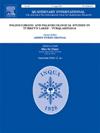Marine terrace staircases of western Iberia: Uplift rate patterns from rocky limestone coasts of central Portugal (Cape Raso - Abano beach and Cape Espichel)
IF 1.9
3区 地球科学
Q3 GEOGRAPHY, PHYSICAL
引用次数: 0
Abstract
The Western Iberian Peninsula is undergoing compressive tectonic reactivation, resulting in spatial and temporal variations of surface uplift. Uplift quantification can be undertaken in coastal settings using staircases of shore platforms developed onto rocky headlands. This study analyses two marine terrace staircases in central Portugal: Cape Raso - Abano beach and Cape Espichel. Geomorphic and stratigraphic analyses identified marine terraces/shore platforms developed below a culminant shore platform, four at Cape Raso and eleven at Cape Espichel. The terrace chronology was obtained by using ESR and pIRIR dating. Using the interactions between the elevation, age and global mean sea-level elevations, the marine terraces were correlated with Marine Isotope Stages (MIS). The shore platforms at the Cape Espichel are more elevated than the coeval references at the Cape Raso - Abano beach and this indicates differential uplift. Considering the culminant shore platform (3.7 Ma), for the Espichel W promontory the estimated long-term uplift rate is ∼0.03 m/ka, but for the Cape Raso is only ∼0.01 m/ka. Also, by using the shore platform considered as produced by the MIS 15 high stand (∼572 ka), the estimated uplift rate for the Espichel W promontory is ∼0.13 m/ka, but for the Cape Raso is ∼0.07 m/ka. The Espichel W promontory terrace staircase also allows to deduce that the estimated uplift rate was nearly constant during ∼600 ka to ∼200 ka ago (∼0.13–0.11 m/kA), but it after decreases (∼0.06–0.01 m/ka).
伊比利亚西部的海洋阶地阶梯:葡萄牙中部石灰岩海岸的隆起率模式(拉索角-阿巴诺海滩和埃斯皮切尔角)
西伊比利亚半岛正经历挤压构造再激活,导致地表隆升的时空变化。隆起量化可以在海岸环境中进行,使用在岩石岬角上开发的海岸平台楼梯。本研究分析了葡萄牙中部的两个海洋露台楼梯:拉索角-阿巴诺海滩和埃斯皮切尔角。地貌和地层学分析确定了在最高海岸平台下面发育的海洋阶地/海岸平台,拉索角有4个,埃斯皮切尔角有11个。利用ESR和pIRIR测年方法确定了阶地年代学。利用海拔高度、年龄和全球平均海平面高度之间的相互作用,将海相阶地与海洋同位素阶段(MIS)进行了关联。埃斯皮切尔角的海岸平台比同期拉索-阿巴诺角海滩的参考资料更高,这表明不同的隆起。考虑到最高岸台(3.7 Ma), Espichel W海岬的估计长期隆升速率为~ 0.03 m/ka,而Raso角的估计长期隆升速率仅为~ 0.01 m/ka。此外,通过使用被认为是由MIS 15高地(~ 572 ka)产生的海岸平台,估计Espichel W海岬的隆升速率为~ 0.13 m/ka,而Raso角的隆升速率为~ 0.07 m/ka。Espichel W海峡阶地阶梯也可以推断出,在~ 600 ka至~ 200 ka之前,估计的隆升速率几乎是恒定的(~ 0.13-0.11 m/ka),但之后的隆升速率下降(~ 0.06-0.01 m/ka)。
本文章由计算机程序翻译,如有差异,请以英文原文为准。
求助全文
约1分钟内获得全文
求助全文
来源期刊

Quaternary International
地学-地球科学综合
CiteScore
5.60
自引率
4.50%
发文量
336
审稿时长
3 months
期刊介绍:
Quaternary International is the official journal of the International Union for Quaternary Research. The objectives are to publish a high quality scientific journal under the auspices of the premier Quaternary association that reflects the interdisciplinary nature of INQUA and records recent advances in Quaternary science that appeal to a wide audience.
This series will encompass all the full spectrum of the physical and natural sciences that are commonly employed in solving Quaternary problems. The policy is to publish peer refereed collected research papers from symposia, workshops and meetings sponsored by INQUA. In addition, other organizations may request publication of their collected works pertaining to the Quaternary.
 求助内容:
求助内容: 应助结果提醒方式:
应助结果提醒方式:


